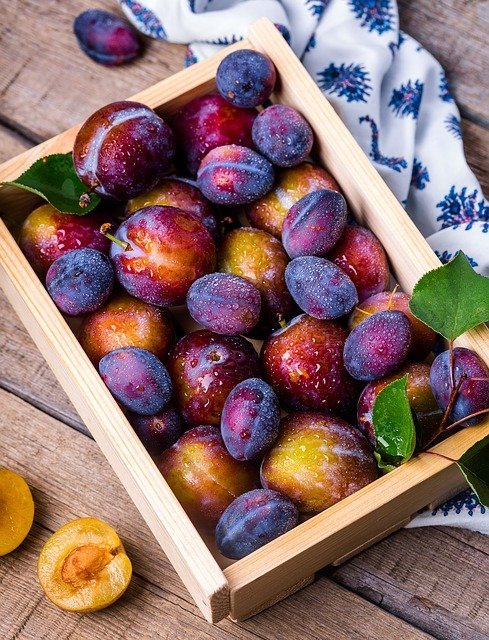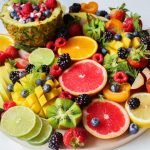
Famous for being the anti-constipation fruit par excellence, fresh or dried plums are an ally of our health thanks to the large amount of potassium, antioxidants and fiber they contain.
Plums, the fruits of the Prunus domestica plant, are a nutritious and satiating food, with a high content of potassium, phosphorus, calcium, magnesium, iron, vitamin A, vitamin C and polyphenols.
We can find them on the market both fresh and dehydrated and the latter, thanks to the drying process that drastically reduces the presence of water, contain a higher concentration of nutrients, easily assimilable sugars, antioxidant molecules and (alas) also of calories, for this reason it is essential not to abuse with the consumption of prunes. In particular, 100 grams of dried plums provide about 236 calories. Before delving into the properties of plums, let’s see an overview of the characteristics of the most popular and popular varieties.
Varieties of plums: characteristics of the most common
Plums are summer fruits rich in properties. Among the many varieties of plums, plums are also classified, which, although they belong to plants of Asian origin (Prunus salicina), are associated with plums proper, which derive from European trees (Prunus domestica). Below is a description of the main varieties of plums.
- Verdacchia plum: decidedly ancient and originally from our territory, it is a wild variety with quite distinctive features. The shape of this plum is elongated, while its skin shows a greenish-yellow color. The pulp, on the other hand, is juicy and sugary;
- Agostana plum: the name of this variety refers to its late ripening, which occurs in August. The casing, which tends to red hues, contains a very appreciable pulp for consistency and degree of sweetness;
- Sangue di Drago plum: this variety boasts spheroidal and large-sized fruits. The skin of these plums has red hues that turn towards purple, enclosing a yellow and sweetish pulp;
- Rusticana Plum: typically Tuscan, this variety contains small wild fruits, characterized by a yellow – red casing and a juicy pulp;
- Plum Goccia d’Oro: this round, medium-sized variety is quite common in our country. As can be guessed from the name, this plum has a yellow-green color at the skin level, enclosing an equally clear pulp. On the whole, they are sweet and juicy fruits;
- Stanley Plum: ovoid in shape and compact in texture, this variety ripens between August and September. The casing is typically purplish and contains a yellow pulp. The taste of these plums is sweetish, sometimes acidic;
- Plum Obilnaja: also of oriental origin, the plums of this variety boast a medium-large size and ripen in the first part of July. The pulp is yellow, tending to orange, and is surrounded by a red-purple skin; its consistency is juicy, while its flavor is pleasant;
- San Pietro plum: ranking among the first varieties to ripen, this plum has a medium size and an ovoid shape. Its skin is yellow when ripe, enclosing a sweet pulp of the same color;
- Plum Sungold: this denomination refers to plums that ripen towards the end of August, large in size and with yellow skin, sometimes pink. The pulp of these fruits is yellow and has a sweetish, sometimes acidic taste;
- Florentia plum: this variety has round and large fruits. The pulp is somewhat sweet and is enclosed by a yellow casing, with shades of red;
- Anna Spath Plum: of European origins, these are medium-sized fruits with a purplish-blue envelope. The yellow flesh is quite sweet, although it is not particularly juicy.
All types of plums have similar nutritional characteristics and beneficial properties. So let’s see what these fruits contain and what they do well.
Plums: calories and nutritional values
Fresh plums contain a good amount of water and fiber, compared to a low content of proteins and fats. They are also a low-calorie food (100 grams of plums provide only 45 calories) and have a good sugar content. From the point of view of micronutrients, however, these fruits are a good source of potassium, magnesium, vitamin C and some B vitamins.
They are also an excellent source of polyphenols, antioxidant substances very common in the plant world. For greater clarity, we report below the table with the nutritional values of prunes.
Nutritional values per 100g of prunes:
- Kcal: 45
- Proteins: 0.5g
- Carbohydrates: 10.5g
- of which sugars: 10.5g
- Fat: 0.1g
- of which saturated: 0.01g
- Fibers: 1.5g
- Potassium: 190 mg
- Magnesium: 6 mg
- C vitamin: 5 mg
- Vitamin B1: 0.08 mg
- Vitamin B2: 0.05 mg
- Beta-carotene: 96 µg
Plums: the health benefits
Plums are useful for intestinal regularity, have a diuretic and purifying action, have good antioxidant properties and are a valid natural tonic (especially the dried version). Let’s see in more detail all the benefits of these fruits.
✓ Draining, detoxifying and useful for intestinal regularity
With 88% water and a good amount of fiber (found especially in the dried quality), plums are an excellent water source but not only, they have an excellent satiating effect and are able to improve intestinal transit, thus acting as a remedy for constipation.
✓ Antioxidant and anti-inflammatory action
Thanks to vitamin A and polyphenols (the most represented are cyanidin, catechin, epicatechin and proanthocyanidins), bioactive molecules with antioxidant action that act by protecting us from the action of free radicals that cause irreparable damage to our cells.
✓ Anti-fatigue and anti-fatigue action
Among the properties of plums we also find this benefit, guaranteed by the large quantity of a mineral, potassium, 190 mg per 100 g. Potassium is in fact a very useful cardiac and muscle tonic, also useful for preventing muscle cramps that can arise after intense sporting activity.
✓ Prevention of osteoporosis
Prunes are said to be able to prevent bone fractures and even osteoporosis in postmenopausal women.
✓ Cancer prevention
To suggest this beneficial property, according to which eating prunes can affect the gut microbiota, thus reducing the risk of developing colon cancer.
How many plums to eat
Plums fall into the fruit category, so one serving of fresh plums is equivalent to about 150 grams. More practically, one serving of plums equals about 2 medium-sized fruits. To guarantee all the preventive and beneficial effects of prunes (including laxative ones) it is advisable to consume at least 4-5 fresh prunes a day, starting with the most important meal of the day, breakfast. Furthermore, if taken in the morning, the laxative effect of prunes will be better. In this regard, if you want to use plums to “go to the bathroom” you can leave 5 or 6 fruits to soak for one night and then consume them the next morning, together with the soaking water.
With regard to dried prunes, however, it should be remembered that it is a rather caloric food and, as such, it is good not to exceed the doses, especially if we are overweight or are following a slimming diet. In this regard, remember that a standard portion of dehydrated fruit is about 30-40 grams and this quantity also applies to dried plums.
Prunes: properties, how many to eat and how to make them
Available at large retailers even after the summer season, prunes (or dehydrated) are plums deprived of the watery part. They are therefore less voluminous than fresh fruits and have longer storage times. Compared to fresh plums, the dry version has more concentrated nutritional components, which also results in a higher caloric intake. In this regard, we remind you that 100 g of dried plums provide just under 240 kcal. As already mentioned above, for the purpose of a balanced diet, it is preferable to consume, daily, no more than 30 – 40 g (2 or 3 pieces). The indicated quantity, or a little more, may already turn out-useful for intestinal motility.
The preparation of dried fruits at home is quite simple. First of all, you need to wash the fruits and blanch them for a couple of minutes. Subsequently, it is preferable to remove the inner core, cutting the plums in two parts. At this point, it is possible to leave the fruits to dry spontaneously, keeping them in the sun for a few days. Alternatively, it is possible to use the oven, placing the plums inside a baking tray (covered with baking paper), and cooking at 60 – 70 ° C for two hours. Finally, it is also possible to use the dryer, an appliance specially created for this type of preparation.
How to use prunes in the kitchen: ideas and tips
Thanks to their characteristic aroma, plums are suitable for making various recipes, especially desserts. Among the most popular and achievable preparations also in the light versions, there are donuts, soft and crumbled cakes, but also pies, mousses and filled biscuits. Also worthy of note are the more classic recipes for the preparation of juices, jams and fruit in syrup.
As far as preserves are concerned, the versions in alcohol are also interesting, mostly made with grappa or cognac. Both for preserves in alcohol and for those in water and sugar, it is preferable to use firm and medium-ripe fruits.
Plums, in their different varieties, are also used to enrich meat dishes. In particular, they are suitable for the preparation of condiment sauces, for the preparation of which it is advisable to use fruits with a marked sweetness.
Cooked plums: what they are good for and how to make them
The cooked version of plums can be useful for flavoring the flavor of fresh fruit with the addition of cinnamon. Subjectively, this preparation could also be useful for intestinal regularity. Without added sugar, a portion of cooked prunes can correspond to about 150 g (raw weight).
To prepare cooked plums, starting from 250 g of fresh fruit, it is necessary to heat 150/200 ml of water and a fragment of cinnamon over low heat. To flavor more, you can also add a clove and lemon zest. In the meantime, it is preferable to cut the plums in two parts and remove the core. At this point, it is possible to add the prunes to the preparation being cooked, stirring occasionally. When the fruit becomes soft (the peel shrivels), you can turn off the heat and let the plums drip, which can be sweetened with a few drops of stevia.
Contraindications of plums
Plums have no particular contraindications, except those due to excessive consumption. In this case, the excessive consumption of plums can cause unpleasant side effects such as diarrhea, bloating and flatulence. In general, then, it is preferable to completely avoid this fruit if you suffer from colitis as it would cause an increase in swelling and spasms.






